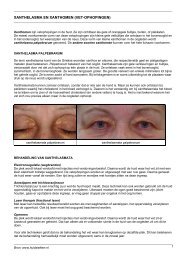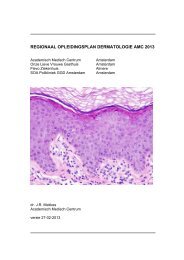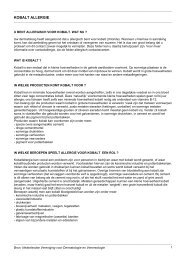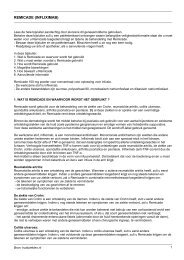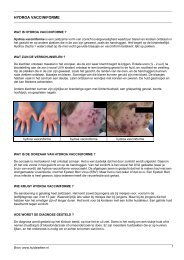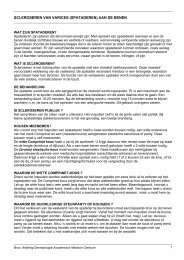Guidelines of care for the management of psoriasis ... - Huidziekten.nl
Guidelines of care for the management of psoriasis ... - Huidziekten.nl
Guidelines of care for the management of psoriasis ... - Huidziekten.nl
Create successful ePaper yourself
Turn your PDF publications into a flip-book with our unique Google optimized e-Paper software.
858 Gottlieb et al<br />
Assessment Questionnaire (HAQ), and <strong>the</strong> Functional<br />
Assessment <strong>of</strong> Chronic Illness Therapy. These<br />
QOL tools have been tested in PsA and found to be<br />
reliable, valid, and responsive to change. The effect<br />
<strong>of</strong> <strong>psoriasis</strong> and PsA on health-related QOL should<br />
be assessed independently. 19<br />
TREATMENT<br />
Mild PsA<br />
Appropriate treatment <strong>of</strong> PsA may include physical<br />
<strong>the</strong>rapy, patient education, and medication.<br />
Because o<strong>nl</strong>y half <strong>of</strong> patients with PsA have progressive<br />
disease, mild PsA is quite common and <strong>of</strong>ten<br />
successfully treated with nonsteroidal anti-inflammatory<br />
drugs (NSAIDs). 20 When o<strong>nl</strong>y a few joints are<br />
involved in patients with PsA, rheumatologists may<br />
per<strong>for</strong>m local intra-articular injections <strong>of</strong> corticosteroids.<br />
Although both NSAIDs and intra-articular<br />
injections <strong>of</strong> corticosteroids can lead to good symptomatic<br />
relief <strong>for</strong> patients with mild PsA, nei<strong>the</strong>r<br />
treatment is capable <strong>of</strong> inhibiting <strong>the</strong> development <strong>of</strong><br />
structural joint damage.<br />
USE OF DISEASE-MODIFYING<br />
ANTIRHEUMATIC DRUGS TO TREAT<br />
MODERATE TO SEVERE PSA<br />
Patients with moderate to severe PsA that is more<br />
extensive or aggressive in nature require more<br />
potent <strong>the</strong>rapy than NSAIDs or intra-articular corticosteroid<br />
injections, ie, disease-modifying antirheumatic<br />
drugs (DMARDs). Un<strong>for</strong>tunately, clinical trials<br />
evaluating <strong>the</strong> efficacy <strong>of</strong> DMARDs in PsA are few,<br />
include small patient numbers, and show o<strong>nl</strong>y moderate<br />
efficacy with high placebo responses. 20<br />
Methotrexate<br />
The data supporting <strong>the</strong> efficacy <strong>of</strong> methotrexate<br />
in PsA, which include two randomized, placebo-controlled<br />
trials, are inadequately powered to<br />
assess clinical benefit. The first study, per<strong>for</strong>med in<br />
1964, evaluated 21 patients with PsA who were<br />
treated with 3 intramuscular injections <strong>of</strong> methotrexate<br />
at 10-day intervals. This treatment resulted<br />
in a decrease in joint tenderness, swelling, and <strong>the</strong><br />
erythrocyte sedimentation rate. 21 In <strong>the</strong> second<br />
study, 37 patients were treated with between 7.5<br />
and 15 mg/wk <strong>of</strong> methotrexate or placebo. After<br />
12 weeks, <strong>the</strong> methotrexate group showed superior<br />
physician assessment <strong>of</strong> arthritis activity compared<br />
with placebo group. 22 Despite <strong>the</strong> paucity <strong>of</strong><br />
evidence demonstrating its clinical benefit, methotrexate<br />
is frequently used as <strong>the</strong> primary DMARD<br />
in PsA, because <strong>of</strong> its efficacy in treating both skin<br />
and joint involvement in patients with psoriatic<br />
disease and its low cost.<br />
JAM ACAD DERMATOL<br />
MAY 2008<br />
O<strong>the</strong>r DMARDs<br />
Sulfasalazine showed modest benefit in a study <strong>of</strong><br />
221 patients with PsA. After 36 weeks <strong>of</strong> treatment,<br />
58% <strong>of</strong> patients treated with sulfasalazine as compared<br />
with 45% <strong>of</strong> patients treated with placebo<br />
achieved <strong>the</strong> PsARC. 23<br />
Leflunomide, a selective pyrimidine syn<strong>the</strong>sis<br />
inhibitor that targets activated T lymphocytes, was<br />
studied in a randomized, double-blind, placebocontrolled<br />
study <strong>of</strong> 188 patients with active PsA.<br />
After 6 months, 59% <strong>of</strong> patients treated with leflunomide<br />
achieved <strong>the</strong> PsARC, compared with 30% <strong>of</strong><br />
patients treated with placebo. 24 O<strong>the</strong>r DMARDs<br />
including antimalarials, cyclosporine, and gold are<br />
less frequently used because evidence <strong>for</strong> <strong>the</strong>ir<br />
efficacy is even less convincing than <strong>for</strong> methotrexate,<br />
sulfasalazine, and leflunomide. 20<br />
For patients with moderate to severe PsA that is<br />
more extensive or aggressive in nature or that<br />
impacts QOL significantly, treatment with methotrexate,<br />
TNF blockers, or both is <strong>the</strong> standard <strong>of</strong> <strong>care</strong>.<br />
Although <strong>the</strong> efficacy <strong>of</strong> DMARDs appears to be less<br />
than <strong>for</strong> <strong>the</strong> TNF inhibitors in <strong>the</strong> limited studies<br />
available, prospective, randomized, adequately<br />
powered, comparative, head-to-head trials are lacking<br />
to support or refute this impression.<br />
Numerous medications intended to treat PsA may<br />
also have an effect on <strong>psoriasis</strong>. For example, most<br />
dermatologists avoid systemic corticosteroids in <strong>the</strong><br />
treatment <strong>of</strong> patients with <strong>psoriasis</strong> because <strong>of</strong> <strong>the</strong><br />
potential risk <strong>of</strong> pustular and erythrodermic flares<br />
when systemic corticosteroids are discontinued.<br />
However, rheumatologists <strong>of</strong>ten use systemic corticosteroids<br />
in <strong>the</strong> short- and long-term treatment <strong>of</strong><br />
PsA, in significantly smaller dosages (5-10 mg/d)<br />
than dermatologists traditionally use in chronic dermatoses.<br />
Between 10% and 20% <strong>of</strong> patients entered<br />
into <strong>the</strong> pivotal clinical trials <strong>of</strong> adalimumab, etanercept,<br />
and infliximab <strong>for</strong> PsA were treated with<br />
concurrent systemic corticosteroids with minimal<br />
observed adverse outcomes. 25-27 Worsening <strong>of</strong> skin<br />
disease with initiation <strong>of</strong> NSAID <strong>the</strong>rapy is occasionally<br />
observed with both nonspecific and cyclo-oxygenase-2-specific<br />
NSAIDs with shunting <strong>of</strong><br />
arachidonic acid metabolites down <strong>the</strong> leukotriene<br />
pathway postulated as a potential mechanism. By<br />
contrast, treatments such as methotrexate and TNF-a<br />
antagonists are useful <strong>for</strong> both <strong>the</strong> skin and joint<br />
manifestations <strong>of</strong> PsA.<br />
In <strong>the</strong> last 10 years, <strong>the</strong>re has been growing<br />
interest in <strong>the</strong> pivotal role that TNF, a proinflammatory<br />
cytokine, plays in inflammation <strong>of</strong> skin and<br />
synovium and this molecule has become a logical<br />
target <strong>for</strong> treatment in PsA with multiple clinical trials<br />
demonstrating that TNF-a blockade is effective in <strong>the</strong>



